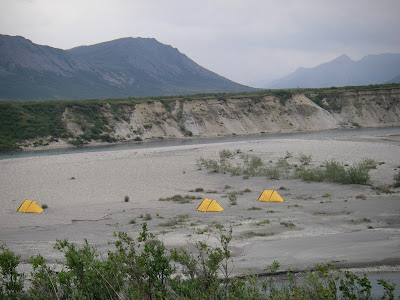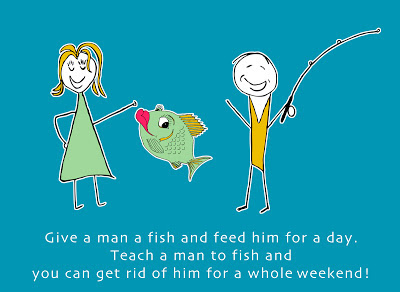BLOG 31. How Much Do You Know About Camping?
by
Cliff Jacobson
 |
| Little Missouri River, North Dakota. Jim Mandle (L); Cliff (R) |
Can you rig a tent so it will withstand an all night storm? Do you know what to do if a bear visits your camp? Are there ways to keep mosquitoes and black flies from honing in on you? Can you make accurate weather predictions without the aid of tools or TV? Take this tough little quiz and see how much you really know about the wild outdoors.
Hint: Some questions have more than one right answer, and some answers are “open to interpretation”.
QUESTIONS
1. You are camping at a popular site. Your freeze-dried and canned foods have no odors to attract bears. Still, you are concerned that a hungry bruin might find your camp. Best plan is to:
a) attach a rope to your food pack and hoist the pack into a tree. The pack should be at least 15 feet off the ground. Rope marks on a large limb suggest that other campers have “treed their packs” here.
b) Set your food pack inside your tent or car.
c) Place your food pack under an overturned canoe or fishing boat. Set metal pots on top of the canoe or boat to function as an “alarm system” if a bear comes while you’re sleeping.
d) Take your food pack out of the campsite and hide it in the bushes, well away from animal trails.
1. ANSWER: d) is the best plan. Habituated bears know that food comes in cans, packs and boxes. They quickly learn that food grows on certain trees! Why? Because there are usually just a few trees in a typical campsite with limbs that are high enough to discourage a bear. Campers all put their food in these trees. Bears are excellent climbers! Indeed, they are so adept at getting treed food packs, that campers in western parks call the treed packs “bear piñata’s”.
 |
| Black bears are excellent climbers. This bear is high in a tree, in an eagle's nest. It's after the eaglets or tasty eggs. |
2. The best way to keep water out of your tent when it rains is to:
a) Dig a trench around the perimeter of your tent and slope the trench so rain water drains away.
b) Place a plastic ground cloth under the floor of your tent.
c) Place a plastic ground cloth inside your tent.
d) Pitch your tent on a slight incline so that flowing ground water will drain away from your tent.
2. ANSWER: “C” is correct. Groundwater commonly enters a tent through ground level seams or worn fabric. An interior ground cloth keeps accumulated water away from your sleeping gear. NOTE: It is unethical and illegal to “ditch” a tent!
 |
| Note interior plastic groundcloth. Tent is a NEMO 2P |
3. Which is the best way to sharpen a knife? Raise the blade about 15 degrees to the stone and:
a) cut firmly into the stone with a long sweeping motion.
b) draw the edge away from the stone with a long sweeping motion;
c) hold the stone steady and rotate the blade in small circles.
d) hold the knife steady and rotate the stone in small circles.
3. ANSWER: (a) will best provide a uniform sharp edge. Use “C” if you have a very small whetstone: however, this procedure will not produce a uniform sharp edge. “d” is ineffective and possibly dangerous.
 |
| Cut INTO the stone, like you're taking a slice out of it |
4. True or False: Modern polyester-filled sleeping bags should be drycleaned or washed by hand: they should never be washed in a washing machine.
4. ANSWER: False! Never dryclean synthetic sleeping bags or fleece garments. The drycleaning solution may dissolve the fibers! Machine washing with gentle detergents is the best plan.
5. Which of these would make the best tinder for starting a campfire on a rainy day?
a) newspaper, b) finely split cedar wood, c) dry splittings taken from the stump of a dead pine tree, d) dead leaves
5. ANSWER: conifers concentrate highly flammable resin (pitch) in their roots. Splittings taken from this “fat wood” (c) burn brightly for many minutes, even in rain. Finely split cedar wood (b) also makes great tinder. Dead leaves work only when bone dry and when not in the advanced stages of decomposition. Newspaper is “hydrophilic”--it absorbs moisture from the air--and the poorest tinder of all. Count your answer correct if you said “b” or “c”.
6. Your tent is pitched on an incline. Best plan is to pitch the tent with the:
a) head end facing uphill, b) head end facing downhill.
c) head end perpendicular to the incline (one side of the tent is higher than the other);
d) it doesn’t matter.
6. ANSWER: Pitch your tent across the incline (c) and level your bed by placing spare clothes under the down hill side of your sleeping pad. This will produce a level sleeping platform.
7. You’ll be the master of any camping and boating situation if you know these three important knots:
a) bowline, square knot, tautline hitch;
b) bowline, crown knot, fisherman’s knot;
c) diamond hitch, square knot, two half hitches;
d) two half hitches, sheetbend, power-cinch (trucker’s knot).
7. ANSWER: (D) will “do it all
8. Whenever you pitch a tent or rain tarp, or rig a clothes line in camp, you should always end your knots with:
a) a double half-hitch around the bite;
b) a slippery or quick-release loop; c) a bow;
d) a monkey fist or crown.
8. ANSWER: End your knots with a “slippery” loop (b) and they’ll come apart instantly when you pull the bitter end of the rope.
9. You are boating on a large lake and are “mightily confused”. Fortunately, you have a simple map and a battery operated GPS (global positioning system). The map in your GPS is very basic, with little detail. Your paper map is better; it shows the structure of the shoreline and the major islands, but there are no contour lines or latitude/longitude marks. The direction of true north is given, but the magnetic declination for the area, is not. You planned to stay near shore so you didn’t program the GPS with your starting position.
To find your way “home”:
a) turn on the GPS and obtain a coordinate fix. Follow the bearing provided by your GPS to your starting point..
b) Your paper map does not have a coordinate system so the numbers provided by your GPS are useless. Use your compass and try to backtrack.
c) You must know the area magnetic declination to program your GPS.
d) Your map does not have contour lines so both your GPS and compass are useless!
9. ANSWER: Your GPS is useless (b)! You must program your starting position to get a “bread crumb trail” home.
 |
| You must program your starting point if you plan to return to it. |
10. Your map shows a small fishing pond deep in the woods, about two miles due south (true bearing equals 180 degrees) of your location. The magnetic compass declination (as given on the map) is 10 degrees west. What magnetic compass heading must you follow to reach the lake?
10. ANSWER: a) 190 degrees
11. A storm is brewing as you are setting up your tent. You should pitch your tent:
a) with the entry-way facing the wind;
b) back-end facing the wind;
c) on a quartering angle to the wind;
d) the direction makes no difference.
11. ANSWER: Back-end (b) or quartering (c) to the wind is usually best. This keeps door zippers and seams in the lee of wind-driven rain. This is more important with A-frame style tents than with domes. Some A-frame tents have one end higher than the other. It’s best to pitch them with the low end facing the wind.
12. You cook your meals on a gasoline trail stove. Which of these is a bad practice?
a) Dump out the gas after each trip and burn the stove dry. Fuel up with fresh gas just before each trip;
b) Never refuel a hot stove;
c) Don’t set over-size pots on the burner of a small trail stove.
d) Use unleaded automotive gasoline in “multifuel” stoves.
12. ANSWER: (d) Automotive fuels are much dirtier--and may be more volatile--than refined naphtha (Coleman and Blazo fuels). Regular use of auto gas will clog valves and put your stove out of commission. Best to burn naphtha (white gas) in your multifuel stove. Gasoline left in stoves for long periods turns to varnish. If you must keep fuel in approved cans or bottles over the winter, keep the containers nearly full to reduce oxidation.
13. Which of these clothing combinations would be bad to wear in cold, rainy weather where hypothermia is a concern? Clothing layers are listed from the skin out.
a) wool long underwear, wool shirt, rain coat;
b) polypropylene long underwear, polyester fleece sweater, rain coat;
c) polyester long underwear, wool shirt, rain coat;
d) cotton long underwear, polyester fleece sweater, rain coat;
e) wool long underwear, cotton shirt, rain coat.
13. ANSWER: “d” is unacceptable, “e” is a poor choice. Cotton wicks moisture and heat from the skin and should never be worn in cold, rainy weather. If you must wear cotton, wear it over wool or synthetics. Polypropylene, polyesters and wool can be worn with confidence in cold rains.
14. You have spotted a black bear around your campsite. Fortunately, you have a can of cayenne pepper spray which will deter bears about 75 percent of the time. Which of the following should you never do?
a) spray your food pack and tent entrance with pepper to keep the bear away;
b) spray the bear when it comes into camp;
c) spray the bear only if it attacks you.
14. ANSWER: (a) will get you into real trouble! Bears don’t like to be sprayed in the face with pepper, but they do like the taste of it. When rafters in Alaska sprayed their rubber rafts with pepper to keep bears away, the bears ate the rafts. Don’t test-fire a can of pepper spray around camp. The residual pepper (on the can) might bring a bear to you! Spraying after the bear attacks you may be too late!
 |
| Spray aggressive bears with pepper. DON'T spray "things"! |
15. You’re pulling away from the dock for a day’s fishing on the big lake. The sky is deep blue, but overhead, there are wispy cirrus clouds which resemble mare’s tails.
a) You’d better cancel your trip--a bad storm is brewing;
b) A gentle rain will begin in an hour or so. The rain won’t last long;
c) Don’t worry; it won’t rain today, but it will tomorrow.
d) These are fair weather clouds--you can count on at least two days of good weather.
15. ANSWER: (c) is correct. Cirrus clouds are composed of ice crystals, thrown skyward by an approaching warm front. Nimbostratus clouds (dark gray rain clouds that cover the entire sky) are 24-48 hours behind. It will rain tomorrow, or the next day--probably a slow, long rain.
SCORING
14-15: Expert camper: Your friends shouldn’t go camping without you.
12-13: Guide in training: You are the envy of your friends.
10-11: Faithful follower: Keep learning--you’ll be a pro in a few years.
Below 11: Wishful thinker: You may want to read some good camping books before your next outing!
XXX














































